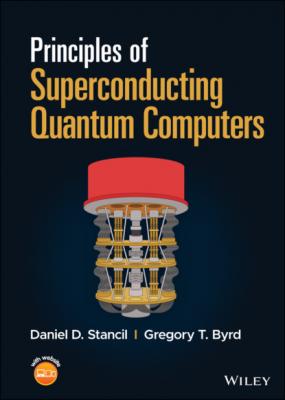Principles of Superconducting Quantum Computers. Daniel D. Stancil
Читать онлайн.| Название | Principles of Superconducting Quantum Computers |
|---|---|
| Автор произведения | Daniel D. Stancil |
| Жанр | Программы |
| Серия | |
| Издательство | Программы |
| Год выпуска | 0 |
| isbn | 9781119750741 |
Principles of Superconducting Quantum Computers
Daniel D. Stancil
North Carolina State University
Raleigh, North Carolina
Gregory T. Byrd
North Carolina State University
Raleigh, North Carolina
This edition first published 2022
© 2022 by John Wiley & Sons, Inc.
All rights reserved. No part of this publication may be reproduced, stored in a retrieval system, or transmitted, in any form or by any means, electronic, mechanical, photocopying, recording or otherwise, except as permitted by law. Advice on how to obtain permission to reuse material from this title is available at http://www.wiley.com/go/permissions.
The right of Daniel D. Stancil and Gregory T. Byrd to be identified as the authors of this work has been asserted in accordance with law.
Registered Office
John Wiley & Sons, Inc., 111 River Street, Hoboken, NJ 07030, USA
Editorial Office
111 River Street, Hoboken, NJ 07030, USA
For details of our global editorial offices, customer services, and more information about Wiley products visit us at www.wiley.com.
Wiley also publishes its books in a variety of electronic formats and by print-on-demand. Some content that appears in standard print versions of this book may not be available in other formats.
Limit of Liability/Disclaimer of Warranty
The contents of this work are intended to further general scientific research, understanding, and discussion only and are not intended and should not be relied upon as recommending or promoting scientific method, diagnosis, or treatment by physicians for any particular patient. In view of ongoing research, equipment modifications, changes in governmental regulations, and the constant flow of information relating to the use of medicines, equipment, and devices, the reader is urged to review and evaluate the information provided in the package insert or instructions for each medicine, equipment, or device for, among other things, any changes in the instructions or indication of usage and for added warnings and precautions. While the publisher and authors have used their best efforts in preparing this work, they make no representations or warranties with respect to the accuracy or completeness of the contents of this work and specifically disclaim all warranties, including without limitation any implied warranties of merchantability or fitness for a particular purpose. No warranty may be created or extended by sales representatives, written sales materials or promotional statements for this work. The fact that an organization, website, or product is referred to in this work as a citation and/or potential source of further information does not mean that the publisher and authors endorse the information or services the organization, website, or product may provide or recommendations it may make. This work is sold with the understanding that the publisher is not engaged in rendering professional services. The advice and strategies contained herein may not be suitable for your situation. You should consult with a specialist where appropriate. Further, readers should be aware that websites listed in this work may have changed or disappeared between when this work was written and when it is read. Neither the publisher nor authors shall be liable for any loss of profit or any other commercial damages, including but not limited to special, incidental, consequential, or other damages.
A catalogue record for this book is available from the Library of Congress
Hardback ISBN: 9781119750727; ePub ISBN: 9781119750741; ePDF ISBN: 9781119750734; Obook ISBN: 9781119750758
Cover image: © Adaptrographics/Getty Images
Cover design by Wiley
Set in 9.5/12.5pt STIXTwoText by Integra Software Services Pvt. Ltd, Pondicherry, India
Dedicated to the pioneers of the first Quantum Revolution, who paved the way.
Contents
1 Cover
5 Preface
8 1 Qubits, Gates, and Circuits1.1 Bits and Qubits1.1.1 Circuits in Space vs. Circuits in Time1.1.2 Superposition1.1.3 No Cloning1.1.4 Reversibility1.1.5 Entanglement1.2 Single-Qubit States1.3 Measurement and the Born Rule1.4 Unitary Operations and Single-Qubit Gates1.5 Two-Qubit Gates1.5.1 Two-Qubit States1.5.2 Matrix Representation of Two-Qubit Gates1.5.3 Controlled-NOT1.6 Bell State1.7 No Cloning, Revisited1.8 Example: Deutsch’s Problem1.9 Key Characteristics of Quantum Computing1.10 Quantum Computing Systems1.11 Exercises
9 2 Physics of Single Qubit Gates2.1 Requirements for a Quantum Computer2.2 Single Qubit Gates2.2.1 Rotations2.2.2 Two State Systems2.2.3 Creating Rotations: Rabi Oscillations2.3 Quantum State Tomography2.4 Expectation Values and the Pauli Operators2.5 Density Matrix2.6 Exercises
10 3 Physics of Two Qubit Gates3.1 √ iSWAP Gate3.2 Coupled Tunable Qubits3.3 Cross Resonance Scheme3.4 Other Controlled Gates3.5 Two-Qubit States and the Density Matrix3.6 Exercises
11 4 Superconducting Quantum Computer Systems4.1 Transmission Lines4.1.1 General Transmission Line Equations4.1.2 Lossless Transmission Lines4.1.3 Transmission Lines with Loss4.2 Terminated Lossless Line4.2.1 Reflection Coefficient4.2.2 Power (Flow of Energy) and Return Loss4.2.3 Standing Wave Ratio (SWR)4.2.4 Impedance as a Function of Position4.2.5 Quarter Wave Transformer4.2.6 Coaxial, Microstrip, and Coplanar Lines4.3 S Parameters4.3.1 Lossless Condition4.3.2 Reciprocity4.4 Transmission (ABCD) Matrices4.5 Attenuators4.6 Circulators and Isolators4.7 Power Dividers/Combiners4.8 Mixers4.9 Low-Pass Filters4.10 Noise4.10.1 Thermal Noise4.10.2 Equivalent Noise Temperature4.10.3 Noise Factor and Noise Figure4.10.4 Attenuators and Noise4.10.5 Noise in Cascaded Systems4.11 Low Noise Amplifiers4.12 Exercises
